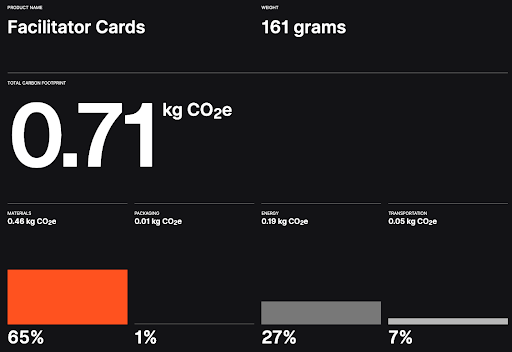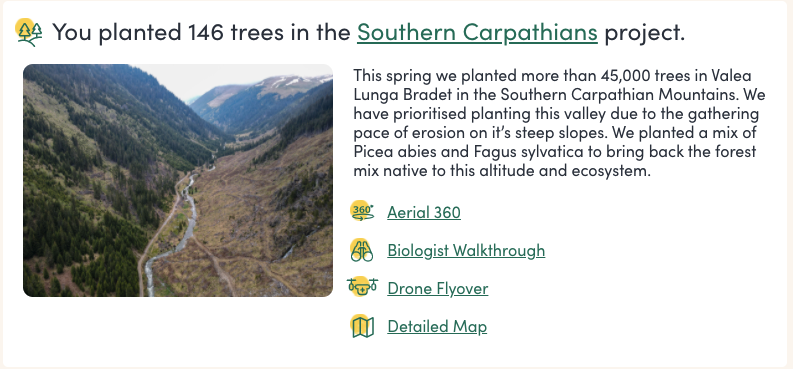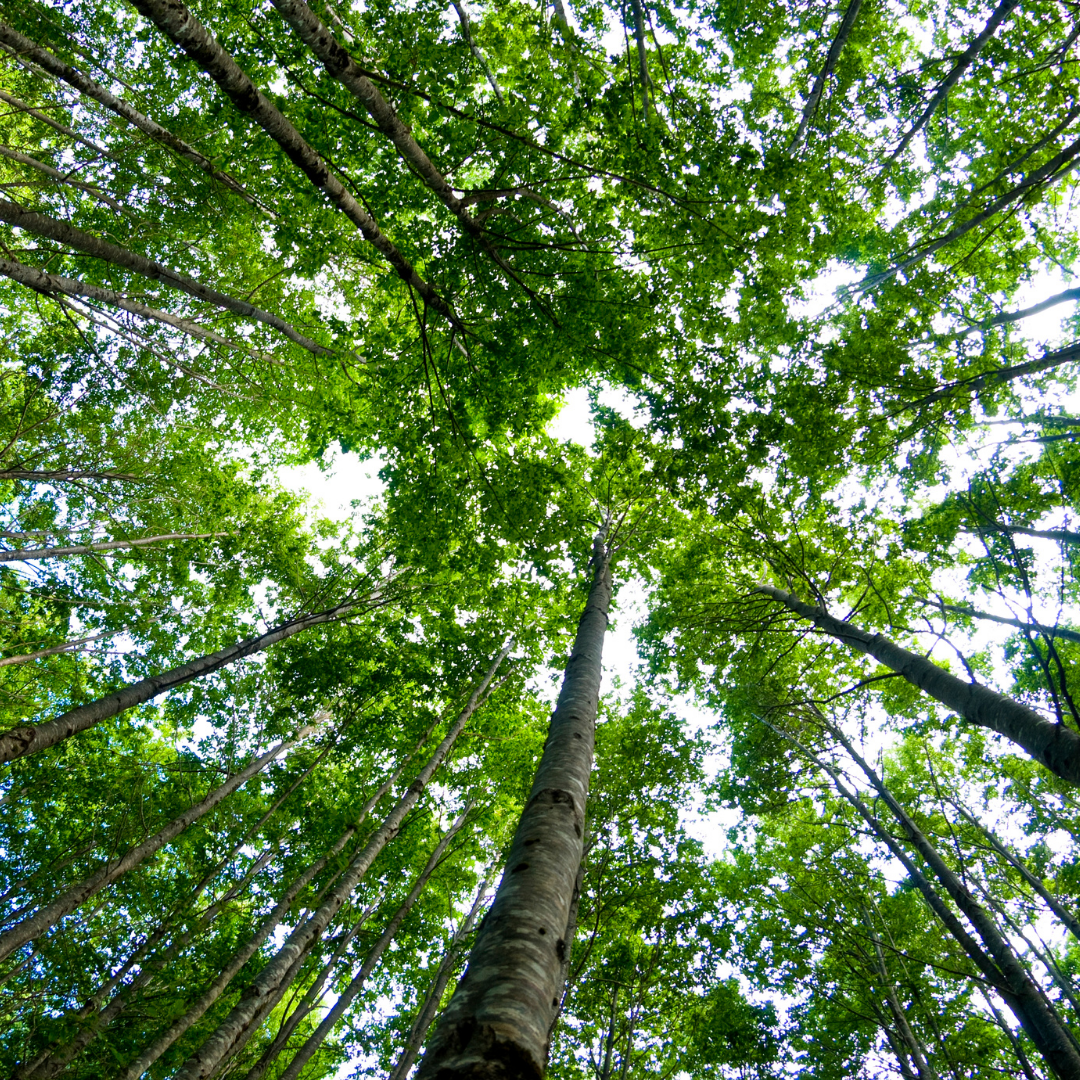Here’s a 98-word version of this blog post.
We wanted to offset our carbon emissions as a company. We found a rad partner to plant trees, Mossy Earth, and we adore them (and think you should too!). We calculated our carbon footprint using free tools and after figuring out our footprint, we decided to offset over 10x what we produce so we could plant more trees and contribute to a happier planet.
We took on this project in a way that other entrepreneurs and small businesses could follow suit so other rad humans might be inspired to contribute to a greener planet.
Let’s get into it.
🌲🌲🌲
When we started down the journey of producing Facilitator Cards, we made a commitment to our Kickstarter backers and to ourselves to create these cards in an ethical and environmentally conscious way. That’s why we are pursuing B Corp certification (currently pending), why we spent countless hours interviewing manufacturers, and why we have pursued offsetting carbon emissions due to the cards being manufactured, shipped, and shipped again (this time to you!).
This last piece—figuring out the carbon footprint of manufacturing and shipping Facilitator Cards and then who to help us plant the all-important trees—is going to be the focus of today’s post.
The Goal
We wanted to calculate the carbon emissions of our manufacturing and shipping in a way that would help us (1) have a reasonably accurate picture of the impact that we were having on the planet and (2) do so in a way that other fellow small-business owners and creators could follow suit!
For that to be true we held ourselves to the following guidelines:
- All the tools that we used to calculate our footprint needed to be available online for free.
- Any tool we used would publicly share the how behind their calculations.
- The tools and process would be straightforward to use and wouldn’t take more than a few hours to work through.
We ended up using a few different tools, the main ones being the DHL Carbon Calculator and the 2030 Calculator. I’ll walk you through our process and then share what we’ve found!
Part 1: Manufacturing Impact
We spent months looking for an ethical US-based manufacturer for Facilitator Cards. Because the cards needed to be plastic and not stained when you wrote on them with a wet-erase marker, this simple task turned out to be an impossible one. There simply weren’t domestic manufacturers who worked with the type of plastic we needed for the cards. Ultimately, we were able to identify a Chinese manufacturer who met all our ethical requirements and then some.
The carbon footprint of manufacturing Facilitator Cards was calculated using the 2030 Calculator (read more about the calculator here). Using it, we were able to estimate the carbon produced to create the raw materials for the cards (plastic for the cards, cardboard for the box), estimate the carbon produced in manufacturing the cards themselves, and then estimate the carbon produced in shipping the cards to our distributor.
After all that, we found that each deck of Facilitator Cards produces about 0.71 kg of CO2e (carbon dioxide equivalent).

Part 2: Shipping Impact
Our cards are located in New Jersey and shipped all around the world. We needed to calculate what the average order that was shipped to the United States or Canada (usually by ground shipping) created in emissions, and what the average order that was shipped internationally (most often to Europe and Australia via plane) created in emissions.
First we made a spreadsheet with the last 20 US/Canadian orders and the last 20 overseas orders and their shipping addresses. Once we had that, we needed the volume and weight of a shipped package in cubic meters and kg.
A typical shipped box of Facilitator Cards are 4”x 4” x 6” which came out to 0.0015 cbm and our typical box weight of .5lbs came out to .22kg.
We then plugged each shipment into the DHL Carbon Calculator using our distributor’s warehouse as the starting location and our customer’s shipping address as the destination location. Once we had the carbon emissions calculation from all 20 North American orders, we used that data to find an average and did the same with the overseas orders.
The amount of emissions increases dramatically when you ship things overseas (unsurprisingly). An overseas order created about 135 times the amount of carbon as a domestic order #planes.
- Average CO2 emission for North American order: 0.02 kg CO2
- Average C02 emission for overseas order: 2.722 kg CO2
Part 3: Calculating the Trees
So now that we had our shipping emissions and our manufacturing emissions we knew the total emissions created for each deck of Facilitator Cards: 0.73 kg CO2 for each deck sold in the US and Canada and 3.43 CO2 for each deck sold to a facilitator overseas.
So how much carbon does a tree offset? Well, that question (like basically all questions when it comes to carbon offsetting) can be as simple or as complicated as you’re willing to get. Different tree species offset different amounts. A sapling doesn’t offset nearly as much as a full-grown tree.
We decided to go with a simple answer. Using the information from our favorite folks over at Mossy Earth, we were able to know that the lifetime carbon offset of a tree is 0.25 tons or 250 kg of CO2.
This meant we’d need to plant 1 tree for every 342 decks of cards shipped in North America and 1 tree for every 72 decks shipped overseas.
Part 4: Deciding What to Do With the Results
Realizing what our carbon footprint actually is was important to us. And realizing how much more carbon selling decks overseas produced was enlightening.
But we also wanted to make it easy on ourselves when figuring out how many trees to plant every month. Fussing with figuring out domestic vs. overseas orders was not going to make that easy. So we decided to just go off of the overseas emissions footprint for every deck sold.
And then we realized that planting 1 tree every time we sold 72 decks wasn’t going to feel very satisfying.
So we decided to 10x it.
We decided to plant 1 tree with Mossy Earth for every 7 decks we sell. That’s 10x the emissions created in a purchase of Facilitator Cards by someone overseas and 45x the emissions created for every deck sold to someone domestically. So when we say we are better-than-offsetting our emissions, that’s about how much better.
Why Mossy Earth
Sam, our co-founder, spent months researching all the different companies that offer carbon offsetting via tree planting and discovered some truly rad organizations and some truly terrible ones. Because being green is now in vogue, there are a lot of companies who want to be carbon neutral and be able to publicly claim they are doing that.
But of course some of the companies ready to plant trees for you are doing so in a hyper-capitalist framework. How cheap can we plant these trees? And many of the companies who are hiring them to plant trees are asking, “What’s the least amount of money I can spend per tree?”
No. Thank. You.
We wanted to partner with folks who had none of this vibe and instead gave us “the planet is incredibly important and precious, let’s help it heal/repair/grow strong together” sorta feels. When we landed on Mossy Earth’s website, we knew they were our people.
They plant indigenous trees in the reforestation efforts they lead—should be a given, but from our research it is most certainly not. They lead rewilding efforts and partner with local organizations. They aren’t a charity for many great reasons. They have incredible dedication to transparency and clear methodologies for their work. We could go on and on and if you’re curious we would highly recommend you read their Business Ethos page to get the full scoop to see why we like ’em so much.
Quite simply, we love giving money to organizations we’re excited about and are stoked to be contributing a portion of our profits from every Facilitator Cards deck sold to Mossy Earth.
Extra Mile: Offsetting Our Website
Something we rarely think about is that websites create carbon. They may “live in the cloud” but they are powered by servers around the world, servers using electricity, electricity which is almost always coming from fossil fuels.
We found another calculator called Website Carbon Calculator and put our facilitator.cards and shop.facilitator.cards sites through the calculator. Our results told us that we need to plant an additional 12 trees a year to offset the carbon for our websites, which we’ll be doing with Mossy Earth every December.
What You Can Do!
So if you’re reading this blog post, you might be feeling inspired to help plant more trees, perhaps with this wonderful company we’ve been gushing about in this post. Well, you can!
If you use this special magic link to sign up for Mossy Earth, they’ll plant 4 extra trees for us and 4 extra trees for you when you first sign up. It’s $12.50 (or £10) a month for them to plant 4 trees. You get to see where in the world your trees are planted, with drone shots and footage of the reforested area. You get your own referral code (so you can inspire more friends) and get access to information and updates about all the projects you’re contributing to.


Here’s some screenshots of our first big order of trees when we first signed up to offset all the Kickstarter and 2020 orders. We share more details about this planting in a future blog post.
If you’re a business, especially our e-commerce friends, we’d love you to join us in offsetting your product’s impact on the world.
If we had gone with the actual cost of offsetting our average order, it would have cost about 1 or 2 cents per deck, so even going with an incredibly ethical company like Mossy Earth offsetting is a relatively affordable thing to do and perhaps more importantly feels and is good to do. It’s very satisfying to know you’ve got some trees out growing and helping. And all the tools that we used to figure out what our carbon footprint was are free and easy to use.
To recap, our process was:
- Use 2030 Calculator to calculate the carbon footprint of manufacturing and shipping to the distribution center.
- Calculate the carbon footprint of shipping an average order using the DHL Carbon Calculator. (We did domestic and international but you could just go for an overall average.)
- Combine the results from step 1 and step 2 to get a total carbon footprint for your product.
- Divide 250 kg by your product’s carbon footprint to know how many products sold = 1 tree planted.
- Extra mile: Calculate the carbon footprint of your website using the Website Carbon Calculator.
For us the hard part was finding the partner, finding the calculators, and figuring out what our process was. If you follow our breadcrumbs you could likely have your answer in just a few hours of work.
More Trees & Happier Bees
Wanting to be an environmentally conscious business that sells and ships Facilitator Cards around the world is complicated. We want to do our best to contribute positively to the planet, to be conscious of every way we show up to make a more beautiful or less beautiful world.
Beyond just offsetting, we work with our manufacturer to cut down all unnecessary packaging and disposable plastic. We ship our cards with recycled materials whenever possible. We’ve made our cards to be durable and, ideally, to last a lifetime.
Doing our part to offset the impact of manufacturing and shipping them around the world was the next step in contributing to the planet we share.
We’ll continue to look for ways to give back to our home. For now, a commitment to more trees and the hopes of inspiring others to come along with us feels like a great place to start.
Start planting trees with us and Mossy Earth!
Facebook Discussion 💬 Join our Group 🤓
